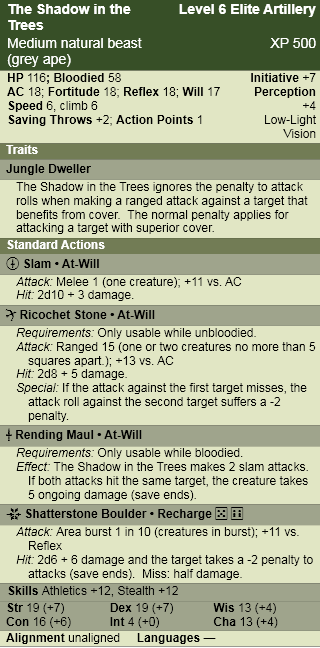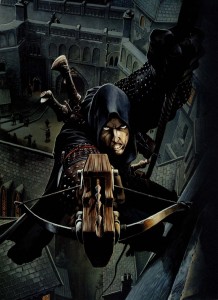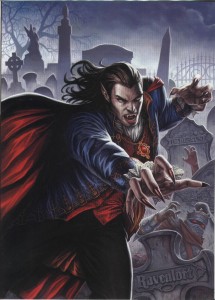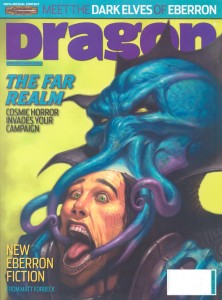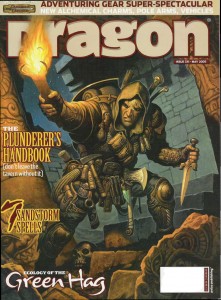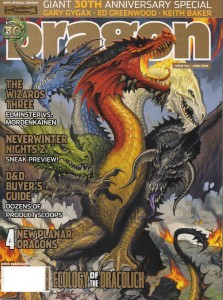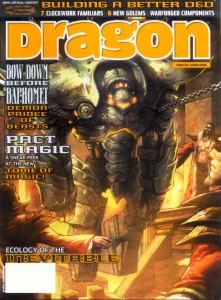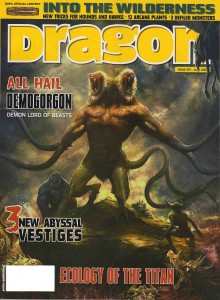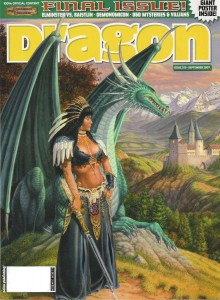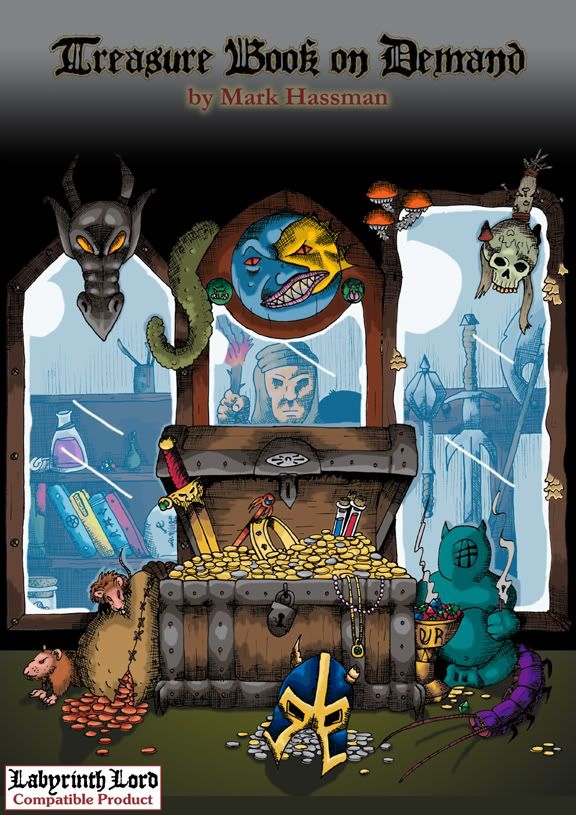 As I promised in my last post, I present my conversion notes for running the Gamma World boxed set’s introductory adventure, Steading of the Iron King, in the world of Rifts. This covers the entire adventure, so the post is a little long.
As I promised in my last post, I present my conversion notes for running the Gamma World boxed set’s introductory adventure, Steading of the Iron King, in the world of Rifts. This covers the entire adventure, so the post is a little long.
Spoiler Alert! If you haven’t played through Steading of the Iron King, and plan to (or if you are one of my players – there’s a ton of spoilers in here about the campaign!) my commentary and walkthrough of the adventure is going to spoil it. Not that there’s any world shattering secrets in the adventure, but still, spoilers. You have been warned.
Introduction
Reading through the adventure when I first picked up the boxed set is one of the things that helped convince me that Gamma World was a suitable rule set for the Rifts setting. The final encounter with the Iron King immediately brought to mind the cover of the Rifts Sourcebook, with Hagan Lonovich sitting on a cybernetic throne, stroking a bottweiler and wearing A.R.C.H.I.E’s interface helmet. Also, for the campaign I am running, I wanted the tone to be a little more serious than the ‘stupendico’ installation evoked, and the mixture of insane A.I. and Wizard of Oz that is Cyberworks in Rifts seemed a perfect fit (deadly serious and ridiculous at the same time).
I moved the action to a pre-rifts Cyberworks facility in the tech heavy area of Mississauga, just outside of Toronto, now the magic rich city of Lazlo (as a Torontonian, Lazlo’s prominence in the world of Rifts is one of the features that attracted me to the setting in the first place). In Rifts canon, A.R.C.H.I.E. 3 and Cyberworks are located underneath the Aberdeen proving ground in the state of Maryland. I try not to break canon when I use an official setting, but I do like to bend it (there’s nothing wrong with breaking canon, but I find working within it a useful tool to the thought exercise of building a campaign), so in my game, A.R.C.H.I.E. 3 is only the most successful of Cyberworks’ experiments in artificial intelligence. Scattered across North America are other facilities with less developed A.I.s, including A.R.C.H.I.E. 7 in Mississauga.
Background
Once the players had developed their own backstories, laying out their motivations for joining a mercenary company working for Lazlo (‘the Misfits’ mentioned in the previous post), I used the following vignette to set up the adventure:
Against all odds, for the past two weeks, life has been sweet. Sitting in you bunker atop the bombed out shell of an old hotel, the most dangerous obstacle you’ve had to face was boredom. The ruins of the lonely highway, the highway for one, over which you have been keeping watch, has lived up to its name. Two days ago you even had the fortune of unearthing a pre-rifts mini-bar with its contents intact! Some of it was even fit to drink.
The recent war between the Coalition and Tolkeen has everyone on edge. That was the reason the city of Lazlo hired you in the first place. With more troops than they could spare reinforcing their allies to the west, Lazlo’s generals were concentrating what little strength they had, back behind the city walls. That meant they needed mercenaries like you to act as scouts and sentries (early warning systems and cannon fodder), along Lazlo’s most accessible entry routes. But hey, what did you have to complain about? You haven’t heard a peep out of the Detroit and Windsor rifts, and it sure beat dodging dog packs and Xiticix on your own.
Life has been sweet… until yesterday. You were deep in contemplation that it probably wasn’t a good idea to drink anything out of a pre-rifts bottle, even if the seal was intact, when the perimeter microwave fence was tripped. After you pulled your head out of the latrine, you and your team sprang into action. It turned out to be a decrepit robot, waving its limbs threateningly and trying to speak with a busted, crackling loudspeaker. Then, without warning, it caught fire and exploded. Odd, but considering what was walking around the wastelands of North America, not completely out of the ordinary.
Then the same thing happened today. Only this time the robot managed to fire off a small missile into the building next door before it expired. It also gave you a message: “Run program 1! All enemies of the Iron King must be destroyed!” It was a small sample size, but you didn’t like the pattern that was developing. It was time to earn your pay.
Note: Anyone not from southern Ontario probably isn’t going to get the ‘highway for one’ play on words.
The Real Story
The Iron King (his assumed name) and his cronies were once a part of the Bloody Cavaliers, a gang of bandits raiding the area between Lazlo, Iron Heart and Free Quebec. They were sent to the Cyberworks facility by Captain ‘cross-eyes’ Zora, the gang’s infamous leader (nicknamed for her habit of putting iron spikes through the eyes of those foolish enough to stare at her disfigurement), to use Cyberworks’ robot stockpile to create a diversion and distract Lazlo’s defenders.
Instead, the Iron King found A.R.C.H.I.E. 7’s cybernetic control helm and began tinkering with one of Cyberworks’ failed experiments. Unlike the fully sentient A.R.C.H.I.E. 3, this machine intelligence can only communicate empathically and is vaguely self-aware. Mastering control of the facility’s manufacturing capabilities is a long process of trial and error, and unfortunately for the Iron King, exposes the human mind to dangerous levels of psychic feedback. It wasn’t long before such mental damage caused the Iron King to descend into all absorbing megalomania. Cutting off communication with Captain Zora and the rest of the Bloody Cavaliers, the Iron King has taken the first small steps to creating his own robotic fiefdom.
Clues that the adventurers find here might put them on the trail of the Bloody Cavaliers, which is good, since Captain Zora has been busy in Lazlo…
The Handouts
Click on the picture below to download the 2 page PDF. I apologize for the general monochromatic tone; I have a black and white printer, so I make most of my play aids in grayscale.
If you’ve ever played Portal 2, you’ll notice I cribbed most of Cyberworks’ warning signs from that game. I’ve never actually played the game myself (or its precursor), but I found Aperture Laboratories’ signs while Googling ‘insane A.I.’ and I thought they were hilarious.
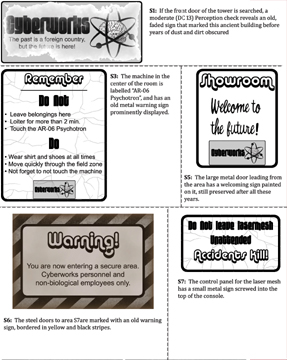
Encounters
Encounter S1: Tower Defense
The old trail you discovered while backtracking the robots’ trail skirts a glowing crater. It ends at the base of an ancient, sunken, office tower, where wastelanders carrying crossbows stand watch, supported by porcine humanoids carrying flails.
For the adventure, I re-skinned the badder steading guards as wasteland vagabonds, which I described as looking like central casting punks out of The Road Warrior (which worked nicely since the armour, weapons, and powers fit perfectly). The porkers I kept as is, but described as looking like the gamorrean guards from Return of the Jedi.
Encounter S2: Tower Interior
Two interior cornices have been converted to guard platforms, where wastelanders wait with crossbows. In the far corner an aerie is heaped with bones and carrion, the roost for a dragon-like creature with iridescent yellow scales. An old carpet, embroidered with runes lies on the floor near the doors.
For this encounter, I made the planter of grab grass into a magically sticky carpet of adhesion, with the same effects. I re-skinned the yexil as a winged dragonsaurus (from the Atlantis book), with the power of acidic spittle, instead of laser eyes (does acid instead of laser damage, but is otherwise the same).
The wastelanders’ barracks room is an old ‘executive quiet room’ complete with scavenged pre-rifts ergonomic cots.
Encounter S3: Warren Entry
A pair of wastelanders are taking cover behind a boardroom table, pushed on its side at the bottom of the stairs. Strange, dust covered statues line the corridor, depicting what looks like an android holding the Cyberworks logo triumphantly in the air.
I re-skinned the badder slave drivers as momma’s boys – wastelanders with pop can sized M.O.M. implants sticking out of their skulls wielding crowbars. I exchanged their flails for crowbars and renamed crippling fail as leg breaker (with the same effect). Fear wave and control pain work fine as is, psychic powers granted by the implants.
Since the human slaves in the cage are effectively brain-dead, I made the destruction of the machine (the AR-06 Psychotron) end their lives and put them out of their misery. It was a little too early in the game for the kind of moral quandary that rescuing vegetative captives presents. Other GMs may feel differently.
Encounter S4: Moth Infestation
The chamber is dimly lit by patches of blue moss that glow with the same radiance as a ley line. An earthen ramp spirals down into an enormous pit in the center of the cavern. Scattered amidst the luxurious clumps of moss are half a dozen humanoid skeletons.
I kept the black blaashes as they were, since radiation shooting, giant moths are perfect for Gamma World and Rifts. I know that radiation was the theme tying the two monsters together, but the blood birds weren’t insectoid enough for me to be teamed up with the blaashes, so I re-skinned them as radioactive stirges (from D&D, not Rifts). All that was needed was to rename radioactive plumage to radioactive aura and beak to proboscis (no mechanical changes).
Since this is an encounter with lurkers and artillery, instead of having the monsters flying around in the open when the encounter began, as in the original text, I had them hiding in the cover of the deep moss, waiting to ambush anything that entered the chamber (such as adventurers lured in to investigate the skeletons).
I also wanted to add a bit more exploration to the session and mitigate the feeling of ‘next room, next combat’ that this adventure is prone to, so when my players decided to scout the chamber’s adjoining tunnels I added the following encounters in.
The walls of the first cave are festooned with strange leathery sacks, stuck to the stone with some kind of secreted resin.
A moderate (DC 13) Nature check reveals the sacks to be blaash egg cases (as well as the danger of destroying them). Like their parents, destroying a blaash egg sack releases an explosion of radioactive goo (close burst 1, +6 vs. Fortitude, 1d6+3 radiation damage). Note: I use Nature for monster knowledge checks about creatures with the terrestrial origin, Science for the extraterrestrial origin, and Arcana for the extradimensional origin.
The secondary tunnel twists back and forth for about 40 ft. and then stops at a dead end. There is a small tracked robot here, similar in design to the one whose trail led the party to this base, trapped in the corner, grinding away its motor in an effort to get out. Judging by the rut in the ground it’s created, you think it’s been here for a few days at least.
Stuck in a failed program, the robot is oblivious to anything the party does, but its volatile construction makes tampering with the machine potentially dangerous. I made this encounter a complexity 1 skill challenge (4 successes before 3 failures), that begins with an easy (DC 9) Mechanics check (opening up the control panel on the robot without damaging it), and ends with a hard (DC 17) Science check (reprogramming the robot to obey the party instead of the Iron King). In between are moderate (DC 13) skill checks that reflect the idea of repairing, reprogramming, and using Kirk-esque cajoling to get the robot to do what the players want (my players used Mechanics, Science, and Interaction respectively).
Success at the skill challenge means the party has reprogrammed the robot and can use it in combat (the robot has 1 Hit Point, a movement of 3, 13 in all defenses; as a standard action an ally can command it to fire its missile which destroys the robot and has the following attack: burst 1 in 10, +7 vs. Reflex, 2d6+7 fire and physical damage, half-damage on a miss).
Failure means that the party has accidentally triggered the robot’s missile, destroying it and damaging themselves (close burst 1, +7 vs. Reflex, 2d6+7 fire and physical damage, half-damage on a miss).
Outside of combat characters can try and get information from the robot with hard (DC 17) skill checks (I allowed a hard Science check to access the robots memory files, which gave the party a glimpse of the map as well as an image recognition file for the Iron King).
S5: Cyberworks Factory Exterior
This encounter is appropriate for Rifts without modification.
S6: Cyberworks Showroom
Light panels on the ceiling flicker intermittently, casting sinister shadows in this stunningly clean chamber of steel and ceramic. Strange machines, labelled AR-72 action inverters, hum and blink in the center of the room. Alcoves line some of the walls, proudly displaying their wares – a veritable legion of robots in various states of decay. The sounds of hydraulic lifts whoosh form adjoining chambers.
The only changes I made to this encounter was to re-skin the soldierbots as A-63 all-purpose heavy bots, with no changes to their powers (the robots seen flanking the throne on the cover of the Rifts Sourcebook, sans rifles).
S7: Cyberworks Restricted Area
Except for a space near the doors, the floor here slopes toward a central trench that is filled, floor to ceiling, with flickering beams of red light. A pair of partial conversion ‘borgs stand on the other side, flanked by two tracked robots that look like the perfected versions of the machine that attacked your bunker at the hotel. Near them is a panel of flickering lights.
I re-skinned the hoop sharpshooters as wasteland head-hunters, armed with JA-11 sniper rifles. I renamed axe hack as bionic wrist claws, and hop as bionic leap (no mechanical change to either). Since I wanted the rocketbots to fit thematically with the opening of the adventure and the robot found in area S4, I got rid of their fly speed, upped their land speed to 5 and gave them the treaded trait (rocketbots ignore difficult terrain).
S8: Cyberworks Factory Floor
A huge mechanized arm hangs from the 30-foot-high ceiling. Machines and dynamos hum along the chamber’s periphery. Two massive vats swirl with scintillating colors; the fluid appears to move on its own. On a 10-foot-high platform at the rear of the room stands a full conversion cyborg with a crazed look in his eyes, wearing a large, almost spherical helmet, connected to the machines by endlessly coiling spools of wires. Standing between you and the ‘borg are a pair of robotic hounds and two scowling juicers. One of the juicers has decorated her light plate armour with the cartoon logo of a bear, the other with the cartoon logo of a frog.
I re-skinned the laserbots as bottweilers (they shoot their lasers from a concealed cannon in their mouths), got rid of their fly speed, increased their land speed to 6, and replaced electrojolt with bite (physical instead of electricity damage). I re-skinned the hoop warriors as the sugar twins, a pair of deadly juicers wielding vibro-swords, replaced axe slash with vibro slash, big hop with steroid jump, and transmuting touch with sundering strike (no mechanical changes to any of the powers). The Iron King kept his name but I re-skinned him as a full conversion cyborg, added the robot keyword, and replaced katana with bionic wrist claws (no mechanical change).
Once the battle is over, characters can try and use the cybernetic control helm. Each use inflicts 2d6+7 psychic damage on the operator (optionally, rather than killing the operator, a character reduced to 0 Hit Points by this can develop an insanity adjudicated by the GM or by rolling on the insanity tables in the Rifts rpg). Characters using the helm can do one of the following: an easy (DC 9) Science or Interaction check reveals what A.R.C.H.I.E. stands for (Artificial Robot Cerebellum Housing Intellect Experiment); a moderate (DC 13) Science or Nature check reveals the location of two other A.R.C.H.I.E. experiments, one in London Towne (pre-rifts London Ontario), and one in the Hammer (pre-rifts Hamilton Ontario); a hard (DC 17) Science or Arcana check (depending on what the character is trying to create) allows the operator to use the mechanized arm and wild nano vats to create an Omega Tech item (draw two cards as a reward and choose one); a successful complexity 1 skill challenge allows the operator to create a bottweiler minion with 1 Hit Point that follows the commands (a standard action) of the operator (this option is guaranteed to kill or drive the operator insane so use with caution).

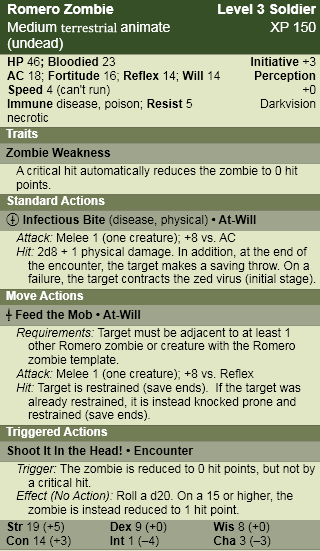
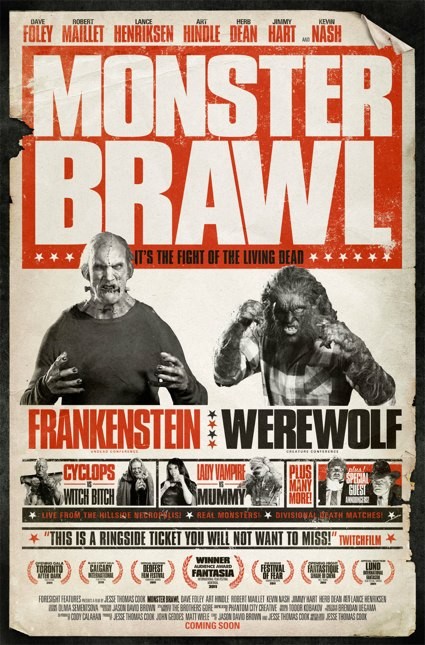

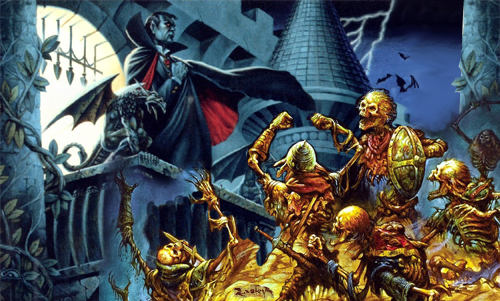


 As I promised in my last post, I present my conversion notes for running the Gamma World boxed set’s introductory adventure, Steading of the Iron King, in the world of Rifts. This covers the entire adventure, so the post is a little long.
As I promised in my last post, I present my conversion notes for running the Gamma World boxed set’s introductory adventure, Steading of the Iron King, in the world of Rifts. This covers the entire adventure, so the post is a little long.


